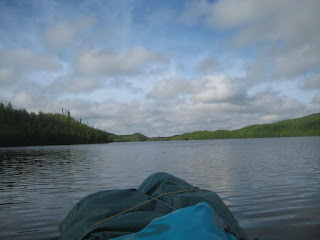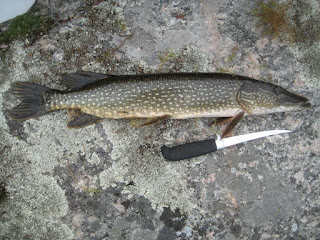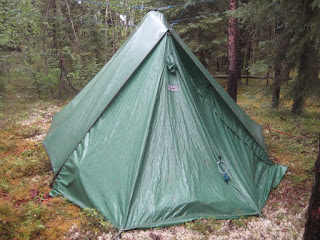June 28 at 4:55 a.m., thick fog as the cold morning air meets the warmer lake surface. I think it is probably a clear sky above (where the daytime heat is lost to the atmosphere). Up at 3:30 a.m., mosquitoes are very bothersome, so after breaking camp 10 and loading canoe, I eat breakfast in the cabin, mostly mosquito free. When I depart, visibility is quite poor, so I use the compass to make sure I am heading in the correct direction.
When the fog clears by 6:30 a.m., it is quite cloudy. So much for my prediction.
As I make my way down the long lake, there are some interesting steep and high bare rock cliffs with various colours of black, brown and yellow. Some blue sky finally appears through whiter clouds. Mosquitoes are very bothersome, even on the lake, so I wear my hat scarf all day.
Reaching the end of the long lake, I am relieved to find a winter portage. Because the winter trail's main destination is Adam's cabins, I thought perhaps it would end there.
Getting to the trail at 9:15 a.m., I have made good time. Unloading the canoe, I carry my usual first load of personal pack with miscellaneous duffel bag on top, and laundry pail filled with gear in one hand. As I make my way, it is obvious that this trail is not as regularly travelled as the main trail to the cabins because I have to step over and around several down trees, fortunately without setting the load down. Near the lower landing there is a 30 metre stretch of muskeg, a bit muddy and wet. On the walk back the 950 metre trail, I take the bow saw, pruners and leather mitts to saw the bigger fallen trees. I trim the alders at the muskeg so I can walk beside or straddle the wet parts. About 100 metres from the lower landing there is a possible campsite if needed, in some open pine and birch. The trail has four steep hills to carry up ... oh yeah! The first slope is 100 metres long and has obviously been a slide playground for otters. They have scuffed up leaves and sticks all the way to the top. I can see their scat containing whitefish scales. Seven portage loads to carry, I am glad someone enjoys the steep hill, not me. As incentive, I promise myself lunch after the portage is done and hopefully after canoeing to a campsite.
Canoeing down the next lake, I check the first likely looking campsite at one point of a small bay. Looking from the canoe near shore it is "okay" and "would do", but from a distance the other point of the bay looks more promising. There is a layer of pines "on top", spruce and birch along the shore, at both spots. The pines also look "level" at their tops indicating flat ground, even though they are up higher than I would like with a steep 45° slope of at least 30 metres.
When I get close to the second site, it indeed appears better, more open at the top of the slope. Noticing one area with possibly the best access from the lake which I mentally flag, I continue checking along the shore to the end of the point before returning to the flagged spot. It is difficult to land but I manage to keep dry by stepping on the thick sweet gale brush, pulling and crawling my way up on shore. With painter rope in hand, I tie off the canoe. The slope is indeed quite steep and long, but even it is fairly open, behind the dense brush, birch and spruce along the shore. Climbing to the top of the hill, I say out loud "yeah"! It looks excellent, open "park-like" under large jack pines. There is a patch of reindeer lichen that should indicate sandy soil so a good place for a firepit. There is a bigger area of open big spruce towards the shore side on a bed of stair-step moss. Yeah ... there should be less bugs here (because of the elevation, the openness, but mainly the thick moss). Decision made ... camp here. Camp 11 is 13 km from the previous camp, including the 950 metre portage.
Hungry ... first thing lunch. On the inland side of the campsite is an area of thicker smaller spruce and birch. Weather is cooperating so no worries there. I fetch the rubber pack, tool bag and bailer full of raw water. A fire is required to shoo blackflies that are more attracted to me because I am sweaty after the seven portage carries. Cutting a small spruce, I make a shovel handle, a pot dingle stick and a fire stick. It is easy to shovel the sandy soil, soon have a fire going and suspend the travel pot of water on the dingle stick over the fire to quickly boil. It is a late lunch, 2:15 p.m., much later than my usual 11 a.m meal.
Hungry ... first thing lunch. On the inland side of the campsite is an area of thicker smaller spruce and birch. Weather is cooperating so no worries there. I fetch the rubber pack, tool bag and bailer full of raw water. A fire is required to shoo blackflies that are more attracted to me because I am sweaty after the seven portage carries. Cutting a small spruce, I make a shovel handle, a pot dingle stick and a fire stick. It is easy to shovel the sandy soil, soon have a fire going and suspend the travel pot of water on the dingle stick over the fire to quickly boil. It is a late lunch, 2:15 p.m., much later than my usual 11 a.m meal.
Unloading the canoe, I store the two heavy barrels right at the landing. I carry all required gear to the campsite, only able to take one pack at a time up the steep slope. Because the thick brush overhangs the lake, I cannot fetch water from shore. With the canoe pulled up on shore a short way and tied to a tree, I walk out in the canoe to dip the bailer which I use to fill the laundry pail standing on shore beside the barrels. Clearing a spot parallel to shore, I then park the canoe. Gear not required in camp goes under the canoe. Coolers go in a moss "fridge" near camp. Then it is time to erect nylon tent, lay out sleep gear and put up the tarp shelter. Hanging my sweat-soaked clothes on the tarp shelter rope, I change into a dry shirt and socks. With a full stomach and dry clothes, I feel so much better. A late supper at 6:30 p.m. and into a very welcome bed by 8:30 p.m.
June 29 at 5:30 a.m, 16℃. Up at 3:30 a.m. to the rumble of distant thunder, which takes over one hour to slowly reach me bringing heavy rain. With a good fire going, I fell several small spruce trees to cut dry boughs for under the tarp shelter before the rain hits. Planning to scout out the next portage, I also bring up gear from the canoe to place under the tarp shelter. As often the case, the surface wind blows one direction and the storm high above moves another. The thunderstorm passes on and the rain stops with some blue sky appearing. This is also common, although multiple storms can move through, one after the other.
After breakfast, I load gear I need to scout and clear or cut the next portage (medium-size tarp, tool bag, rubber pack, gun, fishing kit). The rubber pack contains wading gear, extra clothing, raingear, lunch, pot, maps, ammo, survival gear, satellite phone. I paddle the three km to the upper end of the lake and easily find the incoming rapids. This river enters the lake and then exits about one km down the shore. The sky is relatively clear, a nice day, but mosquitoes and blackflies are bothersome so I wear the hat scarf most of the day. A portage is unlikely on the steep left side, so I canoe across to check the other side.
North American river otters. From my journal: "When I pulled up to the probable landing at rapids, there was a pleasant surprise. A mother otter and two young in the water. I made "kissing" sounds [to pique their curiosity] and got very close. The mother was very anxious for her kids, helping them up on shore by grasping their neck in her mouth. Awesome!"
At 8 a.m, landing at the most likely spot for a portage, near where the otters landed, I search for signs of an old trail with no luck. No more winter portages. There is a game trail at the start that I follow for quite a way, but it never veers towards the river and eventually peters out. Going back to my landing, I walk to the river above the rapids and mark a trail with one orange flagging tape and the rest of the way with broken tops of spruce trees laid in the branches of pines pointing the route.
Fetching my tools from the landing, I start cutting a trail towards the river above the rapids where it is deep but canoeable, not too fast. All three tools are used (bow saw, axe, pruners) but I use the axe a lot to limb and blaze pine trees. Thinking I had selected the best route, I soon realize that the upper portion is too full of big boulders and unsafe holes. Just a bit farther upstream I find a better route, and cutting from the river bank I meet up with my inland trail. Now I block off the wrong trail, falling one blazed pine across it, so as not to get confused when portaging. There is nothing worse than taking the incorrect route when portaging a heavy load, especially the long canoe which cannot be turned around amongst the trees. Close to the river, I fill in some holes with cut branches. When walking empty I can safely navigate dangerous holes, but with a heavy load it is too easy to accidentally make a misstep. At 11 a.m. after three hours, I am finished scouting and cutting this 235 metre portage trail.
Back to the landing, sweat-soaked and hungry, I canoe across the lake below the rapids to the shore where there is a small open area at the base of a steep esker. I scuff out a hole in the sand under reindeer lichen for a small fire to boil a pot of water to drink with lunch and to dry some clothes.
Dousing the coals with the sand, I assemble my fishing rod and canoe to the rapids hoping for a walleye for supper. Making my way near the large boulders, I catch a pike that escaped just as I tried to land him. Then I try four different lures, still hoping to get a walleye, before I catch a 23" (58 cm) pike using my fallback red and white spoon. Canoeing back to the large sloping boulder where I landed for lunch, I clean the fish, my first this year.
The new rod and reel work well. My previous rod had broken several times and last season was reduced to only three sections instead of the original seven. As I depend on fish for at least two meals per week, I did not want to tempt fate so replaced the old reel too. The new outfit is only my fourth set since I was a teenager so they have served me well. One of the attractions of the new rod was the hard protective case. The rod is a carbon fibre four piece "Rapala® Magnum™ MG20SP70M4", the reel "Pflueger President PRESSP35X".
I make my way down the lake about 500 metres below the rapids to check for a campsite which looks good from a distance, medium-sized pines, "level" tops, close to water level. Yes, it is a good site so I prepare it for a move, which will be much closer to the next portage, clearing spots for the nylon tent, tarp shelter and firepit, and making a moss "fridge" close to the lake.
On the three km trip back to camp, it starts to rain, getting me quite damp. Luckily I beat the heavy rain that starts at 4 p.m. with lots of loud thunder that goes on and on. As I walk to the campsite, I startle a snowshoe hare which runs away. Getting a fire started just before it really starts to pour, I sit under the tarp shelter to try to make supper. I keep a big fire going by periodically sawing one metre long poles underneath the tarp to throw on top. Thank goodness I gathered firewood this morning before I left. Managing to cook bulgur before the heavy rain, I eat it along with two mints, fireweed salad and hot water. It is raining so hard that I do not want to venture away from the shelter. Deciding to leave the pike fillets until tomorrow to fry, I brave the rain to take the package to the "fridge" cooler and to fetch a serving of canned corned beef to finish my supper. So now I am even wetter. My shirts only drying slightly at lunch, inner clothes are as damp from sweat as the outer from rain.
The rain stops by 7 p.m. so I build a gigantic fire, crisscrossing the firewood log cabin style about
⅔ metre high. To dry clothes near the fire, I place leather mitts on an angled dingle stick, hat on the chair and string a clothesline across the front of the flames to hang some clothes. Wearing my wet short-sleeved shirt and jeans, I stand close to the fire, alternating front and back as one side gets too hot. I stand a bit too close too long and the jeans get quite hot so that when I bend a bit the material burns my skin. A video-worthy skit follows as I stand up straight and hop around to cool off, trying to pull the hot material away from skin, meanwhile saying a few aie, aie, aie's. Still, the warmth is a pleasant way to end the day. By 8 p.m. the rain resumes so time to go to tent and bed. Rainfall continues all night.
June 30, still raining at 3 a.m., 13℃, I am unable to sleep anymore and get up at 3:30 a.m. Everything is damp including me as I dress in damp clothes. Do I have to erect the canvas Tent and stove? The rain lessens to intermittent showers by 7 a.m. when I am eating a hot cinnamon bannock breakfast with bacon crumbles, Parmesan cheese, hot water ... mmm good! I fry the pike fillets and place in the cooler in triple-bagged medium Ziploc® bags to be reheated for supper. Digging another firepit close to the tarp shelter, I hang some clothes to dry on the ridgeline.
Last evening I removed the bandage from my left big toe, which is still quite sore but I do not know why. Now I put moleskin around the toe beside it and powder the big toe with "Gold Bond® Medicated Extra Strength Body Powder". Doing a sudoku, I am falling asleep after the hot food and heat from the fire.
Last evening I removed the bandage from my left big toe, which is still quite sore but I do not know why. Now I put moleskin around the toe beside it and powder the big toe with "Gold Bond® Medicated Extra Strength Body Powder". Doing a sudoku, I am falling asleep after the hot food and heat from the fire.
By 8 a.m. the rain seems to have stopped and I decide to move camp to the site near the rapids.
A large red squirrel midden near camp 11.





























































